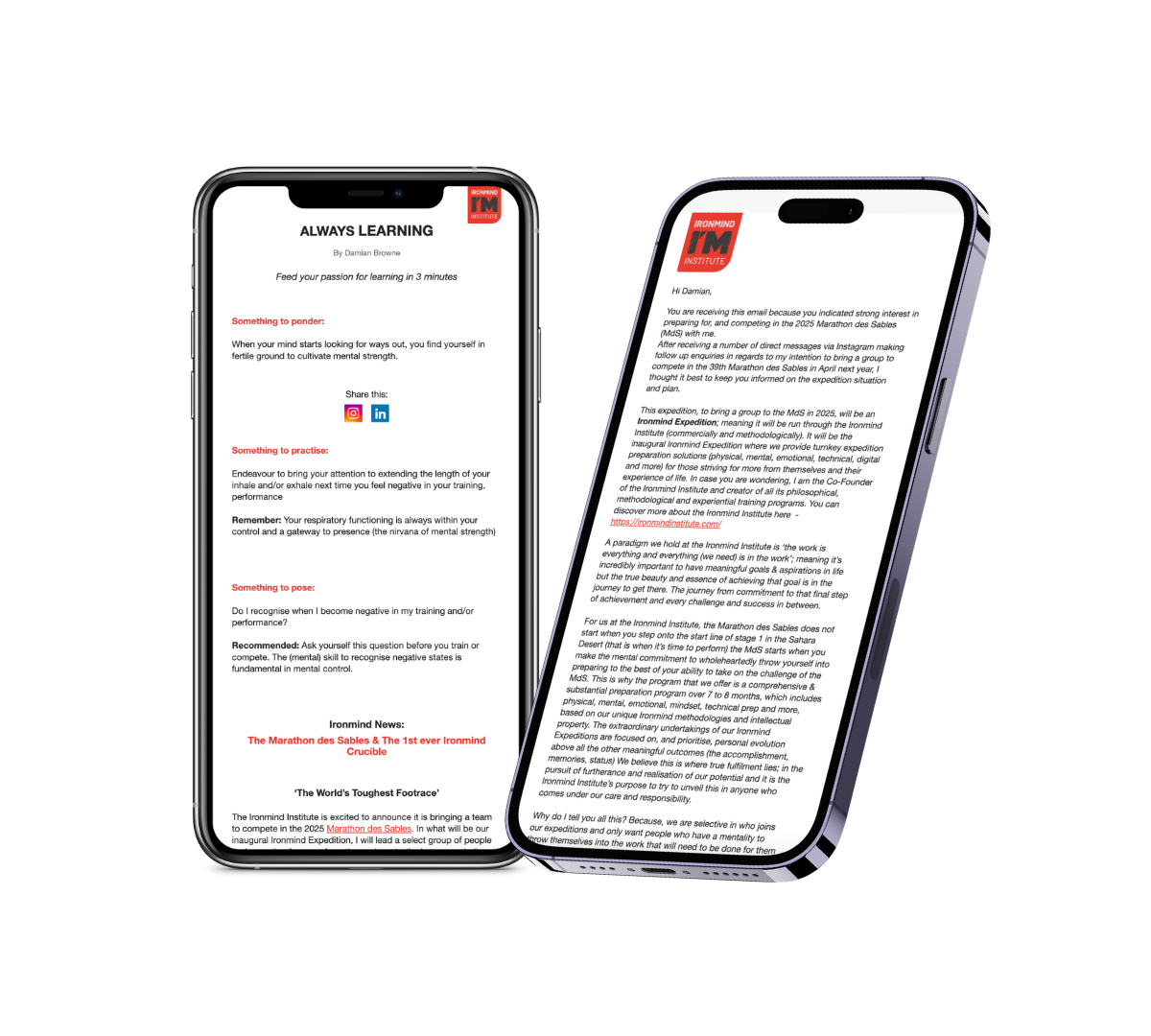The irony for me is, I have a far superior knowledge, understanding and ability to use visualisation techniques now than I did when I was a professional athlete. It’s amazing the depths of learning one can access through responsibility and risk of life. Nothing has taught me more about visualisation than ocean rowing and the harsh reality that if a mistake is made ‘out there’ I am probably not coming home. This truth sharpens the mind to say the least.
Visualisation is a powerful mental skill that may well have saved my life (you can hear that story here) embedded in the methodology of the Ironmind Institute. Certain techniques play a huge role in mental control, mental strength and mental toughness, therefore we promote, coach and practice visualisation with all our Ironmind athletes. But why should it be reserved for athlete’s only? At least that seems to be the only people I hear talking about it. Visualisation is a skill used to prepare for, and improve one’s performance and the sporting arena is definitely not the only environment in life individuals are performing in.
Rehearsal visualisation is a technique in performance used to improve a skill. An athlete, for example, will picture themselves executing a skill and practice that skill in their mind, focusing on the skill as a whole or breaking it down into different stages and the correct technique involved. Some examples would be golfers or tennis players. However skill acquisition is definitely not where this mental skill stops. Rehearsal visualisation can be used to improve decision making, identify stress points and deepen mental strength.
In our signature 4 Controllables Method we use an expanded version of rehearsal visualisation to ‘Pre-Prepare our Awareness’ by scanning through a mental dress rehearsal of the training session/performance/game while inputting –
- Our Approach (mindset, actions)
- Our Plan (Sets, reps, rest periods,
- Our Desired Outcome (What adaptation we are trying to elicit from the session)
- Our Experience History (What we know is highly likely to happen at certain points)
- Stressor Identification (Surveilling the mental performance for stress points)
- Mental Anchors (Mental resets attached to a action within your control
Remember: The depth of one’s visualisation powers is subject to the broadness of one’s imagination. Therefore input as much information and colour as you can imagine into your visualisation. Use all five senses (pro tip – use interoception too) and think in terms of the actions of your nervous system – sensation, perception, thoughts, feelings, emotions and actions/reactions. Visualisation is a (mental) skill. Skills need to be practiced to be improved.
I have asked hundreds of athlete’s the above question and 90% of the answers I have received back have sounded something like this; ‘Not really, no’. However, what I have found on further investigation is that this is rarely true. They have used visualisation, they are just ok not aware of it.
One important characteristic of an athlete that makes them an athlete is – focus. Their disposition to a single-minded focus on their chosen sport (& being better at it) has played a large role in any success they have achieved. However, the vast majority of athlete’s are not sitting around contemplating what they should focus on, or even thinking about what they actually are focusing on. They are just focused. Their why behind what they are doing is strong and driving their focus without a huge amount of awareness around it. A default by-product of the athlete’s focus is the unconscious generation of pictures in their mind of scenarios associated with their training and performance. This is what focus does, whether you are aware of it or not, and these specific pictures help us improve certain aspects of our training and performance (through having played them out in our mind). Next time that specific situation arises in our reality (game, performance, training) we act or react to a higher degree of proficiency. The stronger an athlete’s why, the more time they are going to spend focusing on his/her performance – the more time they spend focusing, the more opportunity for pictures to be generated in their mind, the more time spent playing out specific situations in our mind, the higher chance we will perform more proficiently when faced with that scenario in real life. It’s no surprise therefore that the most successful athletes are hyper focused with an insatiable work ethic.
Does the generation of pictures within one’s mind to improve performance have to be subconscious like it is for the vast majority of high performing athletes? Clearly not. It is an effective mental skill, accessible and available to all to use consciously. The honest reality is you don’t even need a process, it can help in mapping the skill and giving one a foundation but as this is a game of imagination, a process will be limiting, enclosing the mind to a framework when it’s true power is in running free.
Quick Win: Find someplace quiet, close your eyes and imagine yourself into your next important performance (be in a certain training session, boardroom meeting, recital, individual pursuit, team game) and try to identify moments within that where your performance will be stressed; once you have seen it, think about how you would ideally like to react to that stress point so that your performance doesn’t suffer.
'As long as you live, keep learning how to live'
~ Seneca



